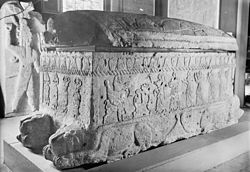Top Qs
Timeline
Chat
Perspective
Ahiram sarcophagus
Sarcophagus of Phoenician king From Wikipedia, the free encyclopedia
Remove ads
The Ahiram sarcophagus (also spelled Ahirom; Phoenician: 𐤀𐤇𐤓𐤌) was the sarcophagus of a Phoenician King of Byblos (c. 1000 BC), discovered in 1923 by the French excavator Pierre Montet in tomb V of the royal necropolis of Byblos.
The sarcophagus is famed for its bas relief carvings, and its Phoenician inscription. One of five known Byblian royal inscriptions, the inscription is considered to be the earliest known example of the fully developed Phoenician alphabet.[1] The Phoenician alphabet is believed to be the parent alphabet for a wide number of the world's current writing systems; including the Greek, Latin and Cyrillic Alphabets, and the Hebrew, Arabic and Urdu Abjads. For some scholars it represents the terminus post quem of the transmission of the alphabet to Europe.[1]
Ahirom is not attested in any other Ancient Oriental source, although some scholars [who?] have suggested a possible connection to the contemporaneous King Hiram mentioned in the Hebrew Bible (see Hiram I).
Remove ads
Discovery

The sarcophagus was found following a landslide in the cliffs surrounding Byblos (in now modern-day Lebanon) in late 1923, which revealed a number of Phoenician royal tombs. The tomb of Ahirom was ten metres deep.[2][3][4]
Sarcophagus
The sarcophagus of Ahiram was discovered by the French archaeologist Pierre Montet in 1923[5] in Byblos.[6] Its low relief carved panels make it "the major artistic document for the Early Iron Age" in Phoenicia.[7] Associated items dating to the Late Bronze Age either support an early dating, in the 13th century BC or attest the reuse of an early shaft tomb in the 11th century BC.
The major scene represents a king seated on a throne carved with winged sphinxes. A priestess offers him a lotus flower. On the lid two male figures face one another with seated lions between them. These figures have been interpreted by Glenn Markoe as representing the father and son of the inscription. The rendering of figures and the design of the throne and a table show strong Assyrian influences.[7] A total absence of Egyptian objects of the 20th and 21st dynasties in Phoenicia[8] contrasts sharply with the resumption of Phoenician-Egyptian ties in the 22nd Dynasty of Egypt.[9]
Remove ads
Dating
The date remains the subject of controversy, according to Glenn E. Markoe, "The Emergence of Phoenician Art".[10] The Ahiram inscription is generally dated to ca. 1000 BCE, as Edward M. Cook notes: "Most scholars have taken the Ahiram inscription to date from around 1000 B.C.E.".[11] Cook analyses and dismisses the date in the thirteenth century adopted by C. Garbini,[12] which was the prime source for early dating urged in Bernal, Cadmean Letters.[13] Also, traces of an erased early Proto-Byblian inscription are visible on the monument.[14]
Others, on the basis of objects found near the sarcophagus, think of a later date, around 850 BCE.[15][16] Arguments for a date in the mid-9th to 8th century BC for the sarcophagus reliefs themselves – and hence the inscription, too – were made on the basis of comparative art history and archaeology by Edith Porada,[17] and on the basis of paleography among other points by Ronald Wallenfels.[18]
Inscriptions
Summarize
Perspective
An inscription of 38 words is found on parts of the rim and the lid of the sarcophagus. It is written in the Old Phoenician dialect of Byblos and is the oldest witness to the Phoenician alphabet of considerable length discovered to date:[19]
(The meaning of the last two words LPP and ŠBL is not well known and has to be guessed at; but it is clear that a curse is meant.[25])
The formulas of the inscription were immediately recognised as literary in nature, and the assured cutting of the archaic letters suggested to Charles Torrey[5] a form of writing already in common use. A 10th-century BC date for the inscription has become widely accepted.
Halfway down the burial shaft another short inscription was found incised at the southern wall, the Byblos Necropolis graffito. The three-line graffito reads:[26]
- (1) ld‘t 𐤟 (2) hn yp?d lk 𐤟 (3) tḥt zn
It is usually interpreted as a warning not to proceed further:[27][28]
- (1) Know: (2) here is disaster(?) for you (3) below this.
Recently it has been proposed that it is part of some initiation ritual which remains unknown in detail:[29]
Concerning knowledge:
here and now be humble (you yourself!)
‹in› this basement!"
Remove ads
King Ahiram
Ahiram himself is not titled a king, neither of Byblos nor of any other city state. It is said that he was succeeded by his son Ithobaal I who is the first to be explicitly entitled King of Byblos,[30] which is due to an old misreading of a text lacuna. According to a new reconstruction of the lacuna the name of Ahiram's son is to be read [Pil]sibaal, and the reading Ithobaal should be disregarded.[24] The early king list of Byblos is again subject to further study.
Remove ads
Heritage designation
The sarcophagus is on public display in the National Museum of Beirut. The General Directorate of Antiquities of Lebanon assembled a list of inscribed objects from different time periods that together illustrate the evolution of the Phoenician alphabet; the sarcophagus is the oldest of these.[31] This list was the basis of a nomination of the alphabet to the Memory of the World International Register maintained by UNESCO. This was accepted in 2005, recognising the objects as documentary heritage of global importance.[32]
Remove ads
References
Literature
External links
Wikiwand - on
Seamless Wikipedia browsing. On steroids.
Remove ads


